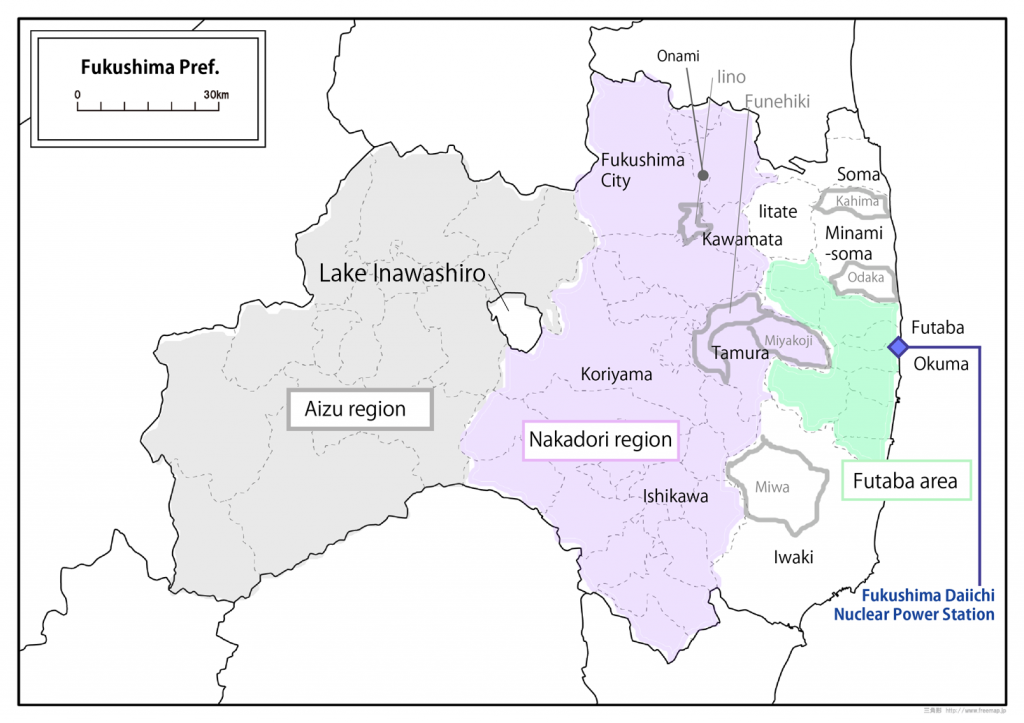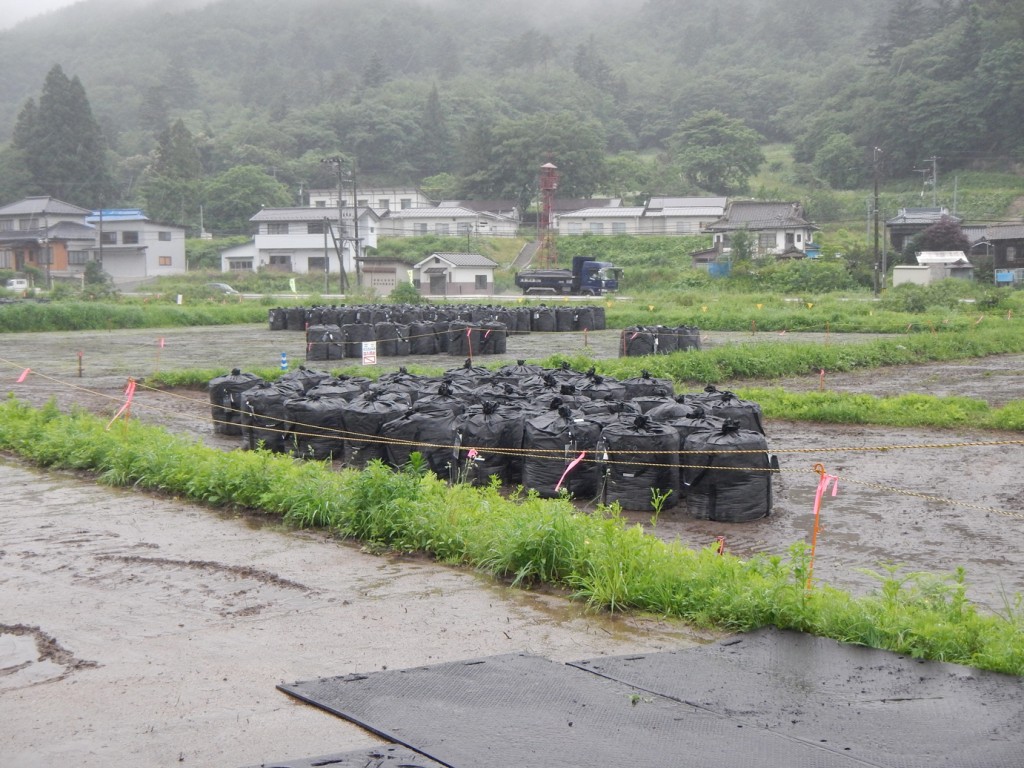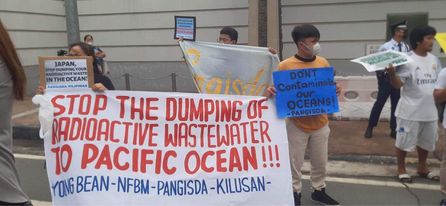Fukushima’s Educational Facilities by Akira Hino -Nuke Info Tokyo No.166
1. Current State of Fukushima Prefecture
Four years have passed since the earthquake and nuclear accident, but almost no progress has been made toward Fukushima Prefecture’s recovery. In particular, the recovery of the Futaba area and its vicinity has just gotten underway. The reason for this delay in recovery has been radioactive contamination resulting from the nuclear accident. The radioactive substances are dispersed widely over Fukushima Prefecture.
Iwaki and Soma suffered damage from the tsunami, but were relatively less affected by radioactive contamination, and thus progress is being made little by little toward recovery in those areas. On the other hand, in the Nakadori region (middle third of the prefecture), where the cities of Koriyama and Fukushima are located, removal of radioactive contamination (decontamination and disposal of waste materials) is necessary for recovery, but that has not been completed yet. In some cases, even after decontamination, radiation doses rise again, so there is no end in sight. The reason this is happening is that no effort has been made to decontaminate the montane forests that cover much of Fukushima Prefecture, and radioactive materials are transported in from the forests by winds and rain.
Two towns in the Futaba area, Okuma and Futaba, have “agreed” to accept interim storage facilities, and the shipment of radioactive wastes into the area has begun. There has been almost no progress on acquiring land for this, however, and when shipments of waste started to arrive only 2% of the total planned area had been secured. Difficulties are expected in future negotiations with the more than 2000 land owners.
Although in these ways the recovery has made no progress, there has been a move toward allowing memories of the nuclear accident to fade away. Divisions among the citizens are being created regarding the question of radiation, and expressions of concern from people about the danger are being contained at the citizen level. There is a growing tendency to call those who talk about the danger “alarmists” or “troublemakers,” so it is becoming difficult for people to discuss it.
Moreover, there have been cases in which compensation paid to the evacuees has caused divisions. For example, a survey has highlighted the concerns felt by citizens of Iwaki City, where many people from the Futaba area evacuated, noting, “The citizens of Iwaki are trying to understand the nuclear evacuees, but they cannot accept the discrepancies in compensation from TEPCO.” 1) Iwaki suffered damage from the earthquake and tsunami. People whose houses were swept away by the tsunami are having to live in temporary emergency housing or rented housing, just like the nuclear disaster evacuees, but they have received no compensation at all, quite unlike the fact that the nuclear disaster evacuees are receiving compensation for their situation. Under such circumstances, it is understandable that many of Iwaki’s citizens feel strongly dissatisfied.
Prime Minister Abe keeps saying that Japan will not recover without the revival of Fukushima, but it is not the citizens of Fukushima that he has in mind, but rather companies and the economy. For example, can the restoration of National Highway 6 or reopening of the closed sections of the Joban Expressway be called “recovery”? These roads merely pass through the Futaba area, from which all of the citizens were evacuated. The people are not allowed to live in the evacuation zones, and there is still no outlook for the return of Futaba’s citizens to their hometown.
2. Educational Facilities Impacted by the Nuclear Disaster
(1) Futaba’s Schools Have Reopened, but…
Prior to the nuclear accident, the Futaba area had about 6,400 children studying at 28 elementary and junior high schools (17 elementary schools and 11 junior highs). After the accident, one by one, the schools gradually reopened in towns and villages throughout the prefecture, and currently 22 of Futaba’s schools have reopened (13 elementary schools and nine junior highs). However, no more than 657 students (as of the 2014 academic year) have returned to Futaba’s schools. Currently, no more than about 10% of the students have returned. Whenever a school reopens, the media report on it, but people feel suspicious about the media’s stance. There is conspicuous coverage giving the impression that reopening means a return to normal. The current reality is that they have barely reached the “starting line.”
(2) Problems with Facilities and Equipment
The existing school facilities include temporary school buildings and schools that had formerly been closed. In some cases, even factories have been converted into schools. When the schools were reopened, they had to start all over again from zero. The preparations for reopening began with arranging for desks and chairs, and through the efforts of the school staff to improvise educational materials and teaching tools, it became possible to provide a minimal level of educational activities. In the four years that have passed, a certain amount of teaching materials and tools have been obtained, but there are still schools lacking special purpose rooms or gymnasiums.
For the children to attend these schools, they have to take school buses from their places of refuge, and commutes of one hour each way are not unusual. Because the times of the buses need to be considered, there are insufficient opportunities to engage in after-school learning support or club activities. Ways have had to be devised to conduct school events in accordance with the small numbers of students along with the conditions of the facilities and equipment. Some of the schools have no incoming students or none graduating, and there have been years in which they were unable to hold entrance or graduation ceremonies, which are important school events. Such conditions are by no means “back to normal.”
(3) Evacuee Schools Outside of Futaba
There are also some elementary and junior high schools located outside of the Futaba area hat were forced to move due to the effects of the nuclear accident.
The elementary and junior high schools of Odaka-ku, Minamisoma are currently holding classes in temporary facilities erected on the grounds of elementary and junior high schools in Kashima-ku. In contrast to the 1,091 students at the time of the earthquake disaster, the number had fallen to 258 students as of the 2014 academic year. In other words, no more than about 25% have returned.
The three elementary schools of Iitate Village have currently reopened in Kawamata, and the junior high school has reopened in Iino. About half of the children present before the earthquake disaster have returned. Almost all of them are commuting by school bus from the area around Fukushima City.
The elementary and junior high schools of Miyakoji-district, Tamura City resumed classes in 2011, using closed school buildings in Funehiki. After the national government’s evacuation order was rescinded, they returned to their original school buildings in April 2014, but when that happened about 20% of the students transferred to other schools. Although the facilities had been decontaminated, there were still major concerns about radiation.
Sad to say, one school has closed: Onami elementary school in Fukushima City. After the nuclear accident, the Onami district had extremely high radiation doses, and one family after another moved away for safety. The last remaining students graduated at the end of the 2013 academic year, and the school closed from 2014. No one could have predicted that such circumstances would arise in an area 60 km distant from the nuclear power plant.
3. Status of Students and School Staff
(1) Issues Affecting the Students
The children of the Futaba area are facing many problems. In particular, junior high school students reaching adolescence have been heavily affected by life as refugees due to the earthquake disaster and nuclear accident. Their parents or guardians who have lost their jobs continue to spend the day at home, there is no place they can be alone in the cramped temporary housing, and at home they have to listen to quarreling or other things they do not want to hear. As a result, there are children who have distanced themselves from their homes.
As a result of the evacuation necessitated by the nuclear accident, the number of families living apart and the number of households with divorced parents are increasing. Moreover, households where a parent or guardian has lost his or her job are able to get by somehow at this time by receiving compensation payments, but they continue to live with the fear that there is no guarantee of their ability to live in peace in the future.
It is best for children to grow up close to their important family, seeing their parents or guardians at work. There are a growing number of children, however, in the midst of circumstances that offer no view at all of what is ahead, who therefore cannot dream of their own future. The biggest victims of the nuclear accident are the children.
(2) Exhausted Teaching Staff
The schools’ teaching staff have been exhausting themselves on a daily basis caring for their students. Each day they seek emotional closeness with the children and improvise their educational activities.
The school staff themselves, however, are refugees. Living in a place to which they are unaccustomed is also a source of unease. In addition, some of them are caring for aging parents or dealing with emotional instability in their own children, making it harder for them to do well by their students. Moreover, each time they make temporary sojourns to visit their homes in the Futaba area, they find their houses are breaking down. It is quite a psychologically trying situation.
These days, society overall is attempting to return to its pre-earthquake state, as if the earthquake disaster and nuclear accident had never happened. While dealing with their own unsettled state of mind, the teaching staff are providing emotional care for their students while trying to meet society’s demands. This unjust situation has continued with no let-up since the earthquake disaster. Thus, there are concerns that the number of people taking sick leave due to psychological disorders will increase.
(3) Psychological Support for the Students and School Staff
Under these circumstances, school counsellors have been assigned to all elementary and junior high schools in Fukushima Prefecture. However, they are allotted only one visit to each school per week, so they are unable to provide sufficient support. There are not enough counsellors in Fukushima Prefecture, so in some cases the prefecture is having counsellors from other prefectures (including the far-distant Kansai region) visit once a week. Fukushima Prefecture shoulders the costs of travel and lodging in those cases, so it is inefficient from a budgetary perspective. Rather than using the budget in that way, it would be desirable for the government to ensure a budget for continual allocation of staff who can meet with the children every day.
4. Current Conditions and Issues of Education in Fukushima Prefecture
(1) Decreasing Numbers of Children and Consolidation of Elementary and Junior High Schools
There are 13,308 children below the age of 18 (as of October 2014) who have evacuated away from Fukushima Prefecture. The number of child refugees has been decreasing, but they are still numerous.
Also, as the number of children has decreased, there has been an increasing tendency to consolidate schools in Fukushima Prefecture. Through the 2014 academic year, consolidations were occurring mostly in the Aizu region—the mountainous western third of the prefecture. From 2015, though, six elementary schools and four junior high schools will be combined into one of each kind of school (one elementary school and one junior high school) in Miwa district, Iwaki in southern coastal Fukushima Prefecture. In neighboring Ishikawa Town, six elementary schools and two junior high schools will be combined into one of each kind of school.
A draft of guidelines issued by the Ministry of Education, Culture, Sports, Science and Technology (MEXT) in January 2015 used the term “appropriate scale,” indicating an intention to promote consolidation of smaller schools. There are concerns that MEXT’s guidelines will affect cities, towns and villages, which are the entities empowered to establish schools. It is unacceptable for schools, which serve as the heart of a community, to be discarded so easily.
(2) Education Policies of Fukushima Prefecture
One matter of concern these days regarding school education is academic advancement. It is important to increase the students’ academic abilities. All of the faculty are striving day in and day out to help their students grow. Their academic advancement itself, however, is being strained by the demands of society.
With one new policy after another on academic advancement being served from above together with criticisms of poor results on scholastic achievement tests, the faculty have too many things to do and are unable to provide educational activities as they would like to. Both the faculty and the students wind up exhausted.
Calls for improving the students’ physical strength are also on the rise. The press has reported that the children of Fukushima Prefecture have been tending to gain weight. Radioactive contamination from the nuclear accident has caused a sharp reduction in chances for the children to play outdoors. In addition, to avoid exposure during travel to and from school, in many cases they go by school bus or their parents drop them off and pick them up.
Fukushima Prefecture maintains that under these circumstances, it is necessary to improve the students’ physical strength. To tell the children to go out like good kids and play in a decontaminated schoolyard, however, would be the height of irresponsibility.
The children’s parents worry that they could risk exposure to radiation if they were involved in activities outside or that their children might get thyroid cancer. Fukushima Prefecture is being called upon to take measures to eliminate these kinds of worries. Countermeasures are being sought such as creating indoor physical education facilities in each district so that the students can obtain exercise at ease without worrying about exposure.
(3) The Kind of Education Needed Now
The government’s meddling in schools, trying to force various policies on them, is in no way leading to improved academic abilities. Would it not be better for them to trust the faculty and give them more leeway? It is the faculty on the scene that best understands the children they see before them. Would it not be the faculty that could devise ways of guiding the children, bringing out the children’s own abilities and helping them achieve real academic ability?
What is important is to urge policies to be created that improve academic abilities, not to cram the children’s heads full of knowledge. It is necessary to get close to the children, meet their gaze and explain to them the importance of learning. It is important to teach the children how to study, so that years later, after they graduate from school, they will have the ability to continue studying on their own. That means nurturing the power to live.
Academic abilities that can be assessed quantitatively, as the Fukushima Prefectural Board of Education wants, are nothing more than one aspect of education. I think that educating the children in a way that does not nip their desire to learn in the bud leads to real advancement of their academic abilities.
It will also be necessary to provide education on radiation in Fukushima Prefecture, where the nuclear accident occurred. This does not mean instruction from the point of view that “radiation is all around us. It’s useful in many fields in today’s society,” as has been taught. The radioactive substances that were spread by the nuclear accident are dangerous for their harmful effects on the human body. For that, the faculty themselves need to study radiation properly. Then through radiation education, they must teach the children properly about the danger of radiation so that the children themselves can acquire the means to protect themselves from radiation.
Unfortunately, discrimination against people from Fukushima on account of radioactive contamination is actually occurring. We must teach the children the spirit not to allow discrimination or prejudice and the strength not to succumb to such things. We must include the perspective of human rights education as a part of education on radiation.
It is important that education on radiation and on human rights be promoted starting from Fukushima Prefecture, which has been affected by the nuclear accident.
Akira Hino is Director of Nuclear Disaster Countermeasures Fukushima Prefecture Teacher’s Union
1) Asahi Shimbun, Sept. 23, 2014, morning edition




